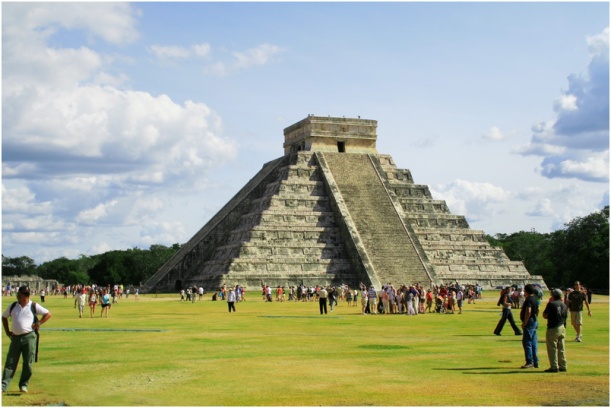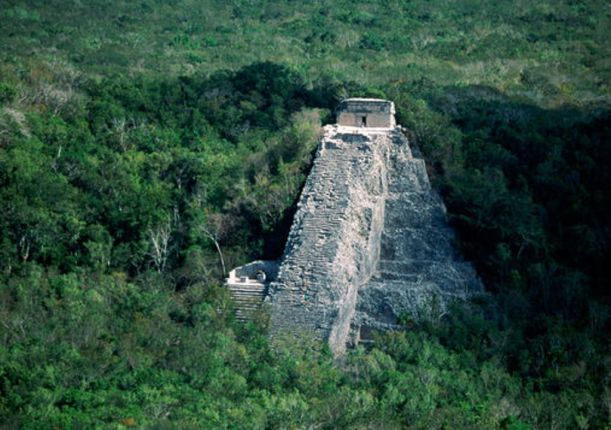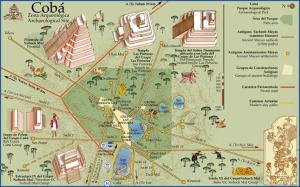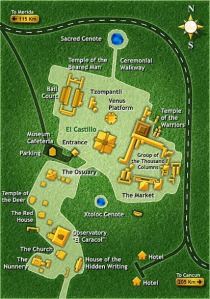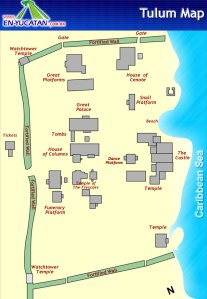You’ve probably heard of Chichen Itza- but did you know there are two other major Mayan ruins you can tour close by?? The ancient cities of Chichen Itza, Tulum, and Coba are unique and amazing examples of Mayan ingenuity. These three archeological sites each give you a different perspective into the Mayan empire and its mastery of mathematics, astronomy, and architecture.
Chichen Itza means “At the mouth of the well of the Itza”, and is named for one of the natural wells, or cenotes, that dot the area. This ancient Mayan city is the 2nd most visited archeological site in Mexico with 1.2 million visitors per year, and was named one of the New 7 Wonders of the World. Of the three Mayan archeological sites near Cancun, Chichen Itza is the most restored- large areas have been cleared and leveled, and several structures have been excavated and restored to their former glory.
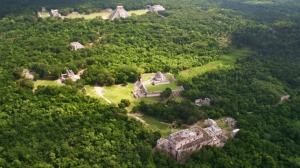
When someone says “Chichen Itza”, you probably picture the iconic step-pyramid, but that is only one small structure in what was one of the largest Mayan cities in its time. The famous step pyramid is called both El Castillo (The Castle) and the Temple of Kukulkan (a Mayan god), and helps illustrate the Maya’s deep understanding of astronomy and time. Standing at 98 feet tall, El Castillo has 365 total steps- one for every day of the year. Most impressively, on the Spring and Autumn equinoxes, the sun casts a shadow that resembles a snake slithering down the staircase, which represents the serpent diety that the pyramid is named for- Kukulkan. Chichen Itza also contains 13 ball courts, 1 skull platform (yep- they displayed human skulls), a steam bath, observatory, the Temple of the Warriors, several other major structures and pyramids, and 2 cenotes. At least one of these cenotes, the Cenote Sagrado (Sacred Cenote), was used for human sacrifices. Over 120 Men, women, and children were painted with a long-lasting pigment, now called Maya Blue, and thrown into the cenote. So much of this pigment was used that scientists have found a 14-foot thick layer of blue goop at the bottom- along with human remains, pottery, weapons, gold, turquoise, and copper. You can tour and swim these cenotes- just remember what (and who) is beneath you! Chichen Itza is a great location if you don’t mind crowds and want to see a (mostly) rebuilt Mayan city.
Tulum is a walled city that sits atop cliffs above the Caribbean Sea. It is the 3rd most visited archeological site in Mexico. The name Tulum means “wall” in the Yucatan language, and it was given by explorers in the 1800s. Because of the protective wall that surrounds the city, it is one of the best preserved Maya coastal cities today.

The Maya didn’t actually use the name Tulum- they called the city Zama, meaning “dawn”, because it faced the eastern sunrise. It is believed to be one of the last cities inhabited and built by Mayas, and it even survived 7 years after the Spanish began their occupation of Mexico. There are three major structures at Tulum- the main structure El Castillo (yes, another one), the Temple of the Frescoes (also used as an observatory) and the Temple of the Descending God. It is believed that El Castillo served as a beacon for canoes to navigate through the barrier reef to the small beach below for trade. Tulum was a major seaport for the neighboring towns of Chichen Itza and Coba, and they traded with people from as far away as Guatemala. If you visit Tulum, make sure to go down to the beach to get the perspective of those who arrived by canoe- the castle on a cliff is a beautiful sight!
Coba was a large agricultural city with approximately 50,000 inhabitants in its heyday- but little else is known. Coba means “waters stirred by wind”, and was probably named after the two lagoons it is located near. Of the 6500 structures estimated to be in the ancient city, only 2% have been excavated- making it by far the least excavated and least restored of the three archeological sites. Unlike Chichen Itza, Coba has not been cleared and is still surrounded by the jungles of the Yucatan. As you walk on these jungle paths, you can spot birds, butterflies, and the occasional spider monkey among the trees. Looking through the jungle you’ll see what look like hills- but these are actually unexcavated buildings covered in plant growth.
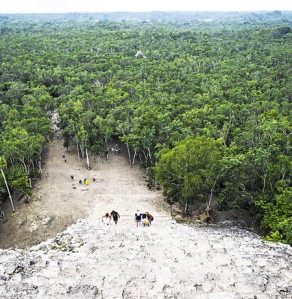
Coba has several pyramids, but the tallest is Nahoch Muul. At 138 feet high, this is the tallest pyramid on the Yucatan, and the 2nd highest in the Mayan world. This is the only pyramid you can still climb, but it’s unsure how much longer that will be allowed. One of the most impressive finds at Coba are the sacbeob, or “white roads”. These are a series of elevated stone and plaster roads that radiate out from the central temple towards other Mayan towns and ruins. The longest of the roads is 62 miles! Parts of the roads have been restored, but most are covered in overgrowth. Since Coba is spread out over a larger area, you can rent bikes or hike around the structures- either way, exploring the jungle ruins is an adventure worth experiencing. If you love Indiana Jones, this is the site for you!
All three are worth visiting, as they each offer such a different experience. Whether you choose the more “touristy” Chichen Itza, the seaside Tulum, or the jungles of Coba, you’ll have an educational adventure that you’ll never forget. Make sure to dress comfortably, bring a bathing suit and bug spray, and to experience some local culture!

